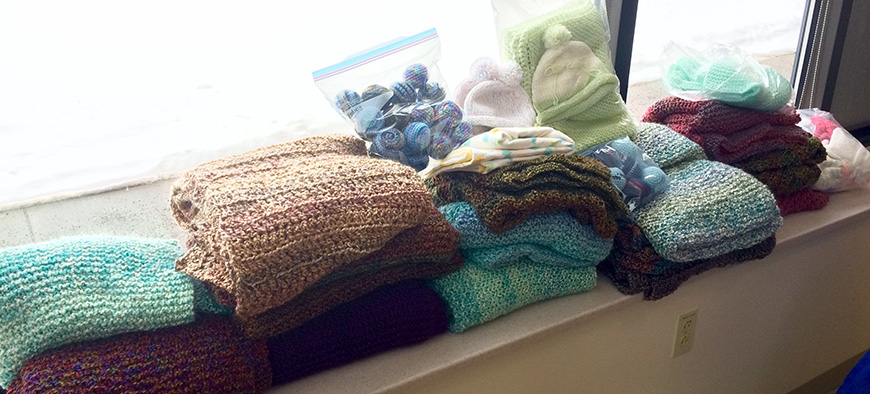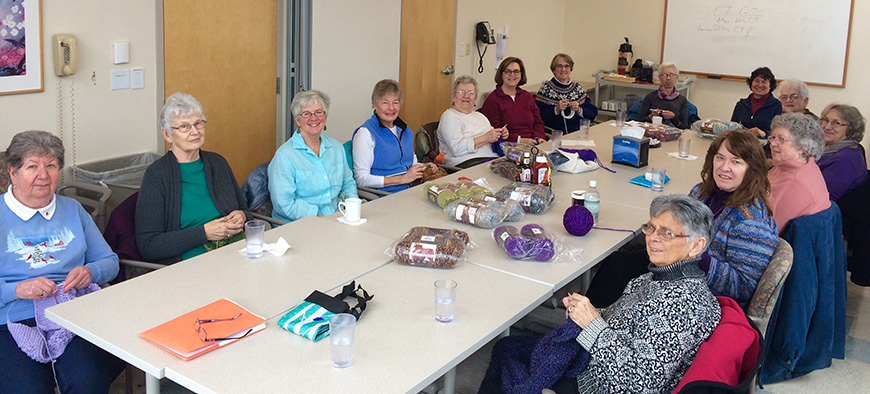
BERLIN – On the first Wednesday of the month, a lively group of volunteer knitters gathers at Central Vermont Medical Center to knit together, share patterns and ideas, and be reminded of the reason they do what they do. CVMC chaplain Priscilla Minkin stops in to share stories of how the items they donate to the hospital and Woodridge Rehabilitation and Nursing change the lives of the people who receive them, as well as the hospital staff members who distribute them.
The CVMC Knitting Group, which started in 2012 as a group of five to 10, has grown in leaps and bounds to more than 30 members, all by word of mouth. Many say that the chaplain’s stories of how their gifts comfort others are what keep them coming back.
“Hearing the stories makes us want to knit even more. It’s so nice to know that our work means so much to others,” one volunteer shared. Another added, “And we look forward to seeing each other every month—we’ve become such friends.”
Minkin has shared many stories over the years, moments she has experienced or heard about that become emblazoned on her heart. She told the knitters about the many family members she wrapped in shawls in the emergency department as their child was dying, and about the dog that slept on the shawl his owner died under. Three daughters told her they had unraveled the shawl she had given to their dying mother to remake it into three scarves to wear in remembrance of her. Another chaplain visited with a young woman at her dying mother’s bedside who was still grieving her father who had died years before; the chaplain wrapped her in a shawl blessed in the name of her father, to represent his arms around her as she sat with her mother. “You have no idea what this means to me,” she said.
Recognizing the value of the service, the CVMC Auxiliary began providing funds for yarn in 2015. Other donations of yarn also come in, and knitters turn them into shawls, afghans, lap robes, hats, blankets, and stress balls (small balls covered with yarn to squeeze when anxious).
In the face of serious illness and death, patients and their families can feel alone, abandoned, and afraid. The gift of a soft, colorful shawl, presented with a blessing or wrapped around shoulders, can bring a smile, tears, a hug, or a much-needed feeling of connection and care. An afghan may represent the love of a deceased relative; a stress ball can stand in for the hand of a loved one who is far away—or be a place to channel frustration.
Nursing staff and chaplains also appreciate having a concrete way to support patients and families, which can ease their own distress when patients they care about are actively dying.
“So many times, we wish we could do more for patients,” a nurse said. “When we can give them these gifts, it makes us feel like we’re doing something—and they’re so thankful.”
In the hands of these volunteers, knitting needles become tools of healing, for patients and their families, for the hospital staff, and in the end, for the volunteers themselves. Arreta Boyd, the group organizer, put it this way:
“I do it to help in whatever small way I can to ease the pain of patients and families. I know what that pain feels like, having lost way too many in my life, way too soon. I only wish there had been such a group at all the hospitals I was in, all those times. It is a circle, as Priscilla said, helping me help them, which helps myself. It gives me hope and comfort to think our efforts make a difference.”

